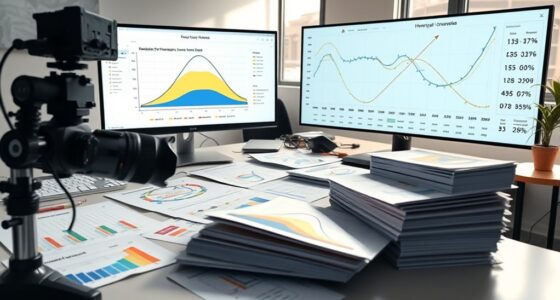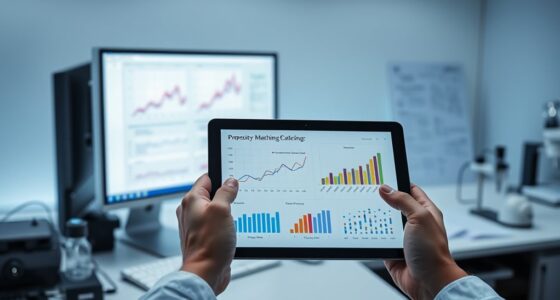Time series analysis involves examining data collected over time to identify patterns, trends, and seasonal fluctuations. It helps you understand how data varies, detect regular cycles, and make forecasts using methods like ARIMA, Holt-Winters, and advanced models. You’ll also explore techniques for managing data quality issues and challenges such as noise or irregular sampling. Staying aware of these fundamentals will guide you in applying effective analysis methods—if you keep exploring, you’ll gain deeper insights.
Key Takeaways
- Time series data is collected at successive time intervals to observe patterns, trends, and seasonal variations.
- Core components include trend, seasonality, and residual noise, crucial for accurate analysis and forecasting.
- Techniques like ARIMA, Holt-Winters, and advanced models help identify and predict future data points.
- Data quality issues such as missing or inconsistent data can distort patterns and affect model accuracy.
- Regular data exploration and model updates are essential for capturing data variability and ensuring reliable forecasts.
What Is a Time Series?
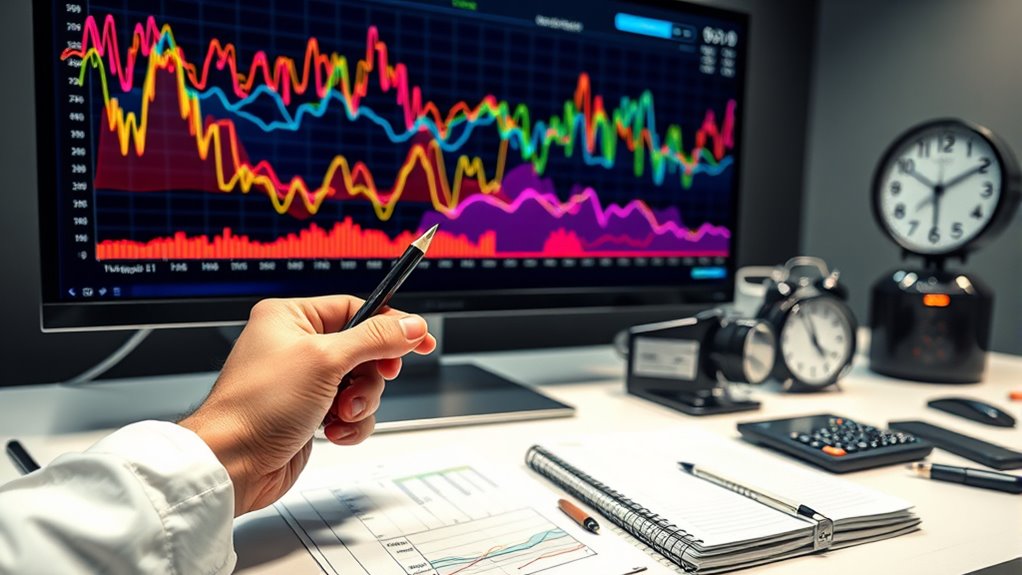
A time series is a sequence of data points collected or recorded at successive points in time. You’ll find these data points are typically organized with timestamps, making the order essential for analysis. This structure allows you to observe how measurements change over periods, revealing trends, patterns, and irregular fluctuations. Time series data is used across industries like finance, manufacturing, and climate monitoring, helping you understand long-term movements or seasonal variations. The data’s stream-like nature means new observations flow continuously, requiring you to analyze both stability and variability. Recognizing components such as trends, seasonality, and residual noise helps you interpret the data more effectively. Understanding the data collection process is crucial for accurate analysis and forecasting, especially when identifying seasonal patterns and other recurring phenomena.
Types of Time Series Data
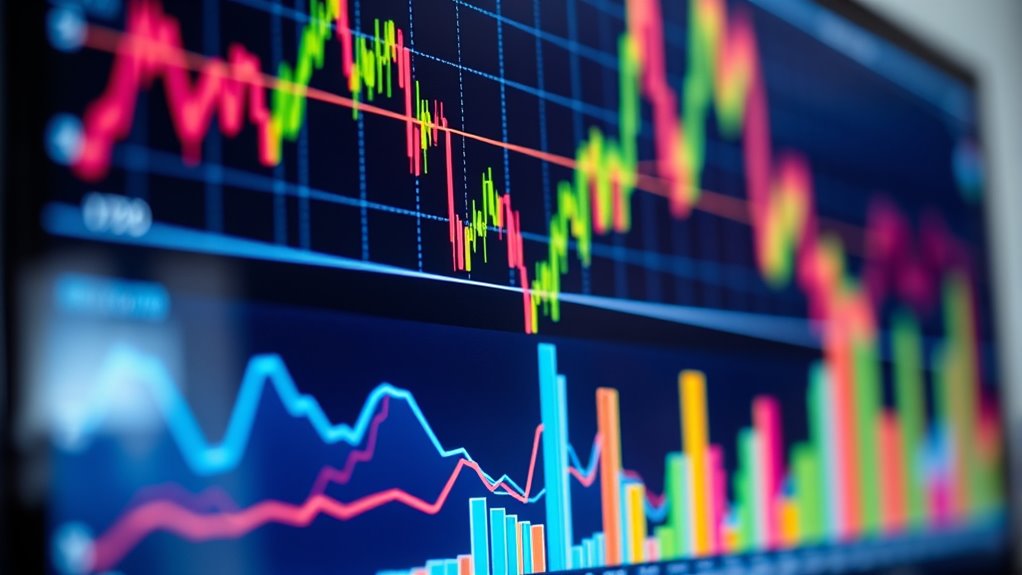
Have you ever wondered how different types of data are collected over time? Time series data comes in various forms based on how it’s gathered. Metrics are measurements taken at regular intervals, ideal for forecasting trends, while events are recorded irregularly, making predictions more challenging. Emergency preparedness emphasizes the importance of understanding data patterns to enhance community resilience and response. Stock data captures static measurements at specific moments, whereas flow data reflects activities over a period, providing broader insights. Sampling methods also matter—regular sampling ensures predictable patterns, while irregular sampling introduces complexity. Recognizing the data collection methods used can help in choosing appropriate analysis techniques to better interpret the information.
Techniques for Analyzing Time Series

Understanding the techniques for analyzing time series is essential for uncovering meaningful patterns and making accurate forecasts. You’ll want to explore methods like ARIMA models, which combine autoregressive, moving average, and differencing components to handle stationarity and model complex data. Forsale 100 can provide additional resources for advanced analysis techniques. Holt-Winters is useful for series with seasonality, smoothing data to predict future points. Autocorrelation analysis helps identify repeating patterns by measuring relationships between data points at different lags, while PACF isolates direct effects between specific lags. Seasonal patterns analysis reveals long-term directional movements, clarifying underlying shifts. Decomposition separates data into trend, seasonal, and residual parts, enhancing understanding of each component. Visual tools like line plots and seasonal subseries plots offer clear, intuitive insights into data behavior.
Forecasting Methods in Time Series Analysis
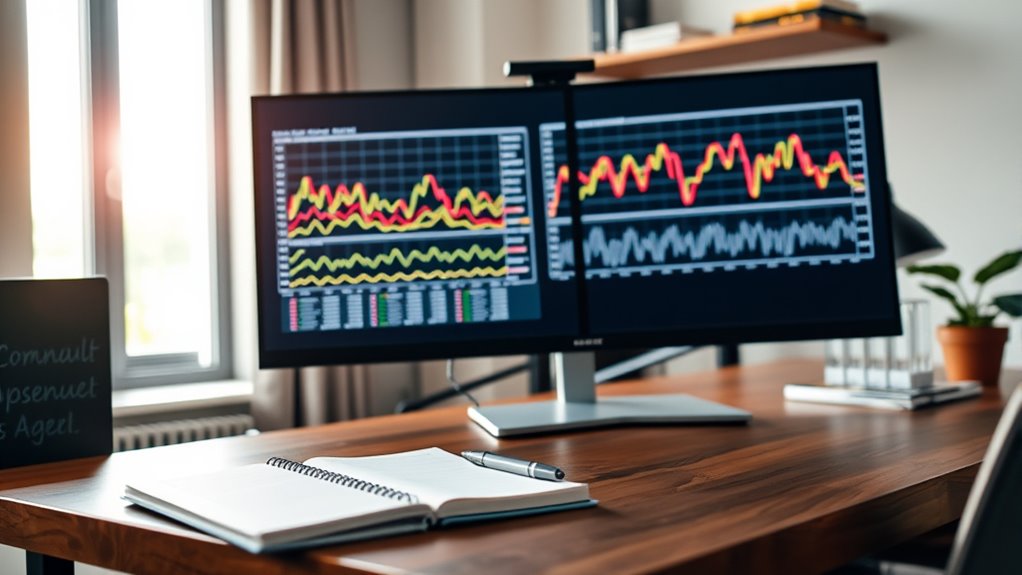
Forecasting methods in time series analysis enable you to predict future data points based on historical patterns. Autoregression (AR) models use past values to forecast future ones, while Moving Average (MA) models rely on past errors. These models are ideal for stationary data.
Combining AR and MA models results in ARMA models, which handle more complex series with trends or seasonality. ARIMA models extend this further by incorporating differencing, making them suitable for non-stationary data.
For short-term forecasts, exponential smoothing techniques like Holt’s are simple and effective. Understanding data stationarity is essential for selecting appropriate models and ensuring accurate forecasts.
When dealing with seasonal data, SARIMA adds seasonal components, and Holt-Winters smoothing captures seasonal trends.
Modern approaches include machine learning models like LSTM and Prophet, which handle complex and non-linear patterns.
Additionally, essential oils like eucalyptus and peppermint are used in aromatherapy to support various health conditions, illustrating the diverse applications of natural remedies alongside statistical forecasting tools.
These methods give you a versatile toolkit for accurate forecasting across various data types and behaviors.
Practical Applications of Time Series Analysis

Time series analysis finds widespread use across various fields by providing actionable insights from historical data. In finance, it helps you predict stock prices, market volatility, and interest rates, enabling better investment decisions and risk management. You can analyze currency fluctuations to manage international trade risks and optimize your portfolio by forecasting future asset values. In healthcare, monitoring heart and respiratory rates over time allows early detection of health issues, while analyzing disease trends supports outbreak prediction and research. Environmental scientists use it for weather forecasting, climate change studies, and water resource management. In manufacturing and logistics, it helps you optimize inventory, schedule predictive maintenance, and improve supply chain efficiency. Additionally, accurate modeling is essential for making reliable forecasts and informed decisions across these domains. The development of noise reduction technology in modern equipment further enhances the accuracy of data collection and analysis.
Common Challenges Faced in Time Series Studies

Analyzing time series data presents several common challenges that can hinder accurate modeling and forecasting. Data quality issues, like missing, inconsistent, or outdated data, can distort patterns such as seasonality and trend. Noise in data complicates pattern detection, while poor data management worsens reliability. Choosing the right model adds complexity; simple models risk missing key trends, while complex ones may overfit noise. Parameter tuning and interpretability also pose problems, especially with black-box models. External factors like economic shifts, market disruptions, or regulatory changes introduce uncertainty that models can’t always account for. Additionally, cybersecurity vulnerabilities can impact the reliability of automated analysis tools, highlighting the importance of robust validation processes. Furthermore, identifying seasonality, trends, and addressing non-stationarity can be difficult. Sampling irregularities and varying frequencies further complicate analysis, requiring careful handling to make certain accurate forecasts. Moreover, AI vulnerabilities can impact the reliability of automated analysis tools, highlighting the importance of robust validation processes.
Tools and Models for Effective Forecasting
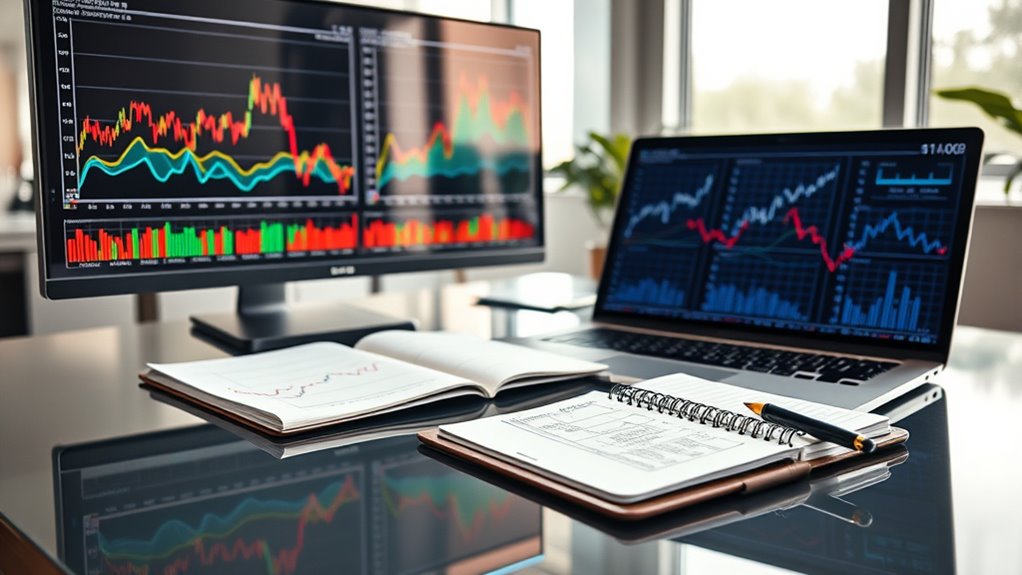
Effective forecasting relies on selecting the right tools and models to interpret historical data accurately. You can leverage tools like ArcGIS Pro’s space-time cubes, which use models such as exponential smoothing and curve fitting to project future values. Incorporating user-submitted anecdotes can provide valuable context for understanding unpredictable patterns in data. InfluxData offers models like ARIMA, ARIMAX, and moving averages, suitable for analyzing diverse datasets. Machine learning techniques, including random forests and ensemble methods, enhance predictions, especially for complex or high-dimensional data. Spatial statistics resources provide valuable tutorials and scripts for advanced analysis. When choosing models, consider your data volume, frequency, and specific forecasting goals. Regular updates and proper data exploration are essential for maintaining accuracy and capturing data variability.
Key Considerations for Reliable Analysis
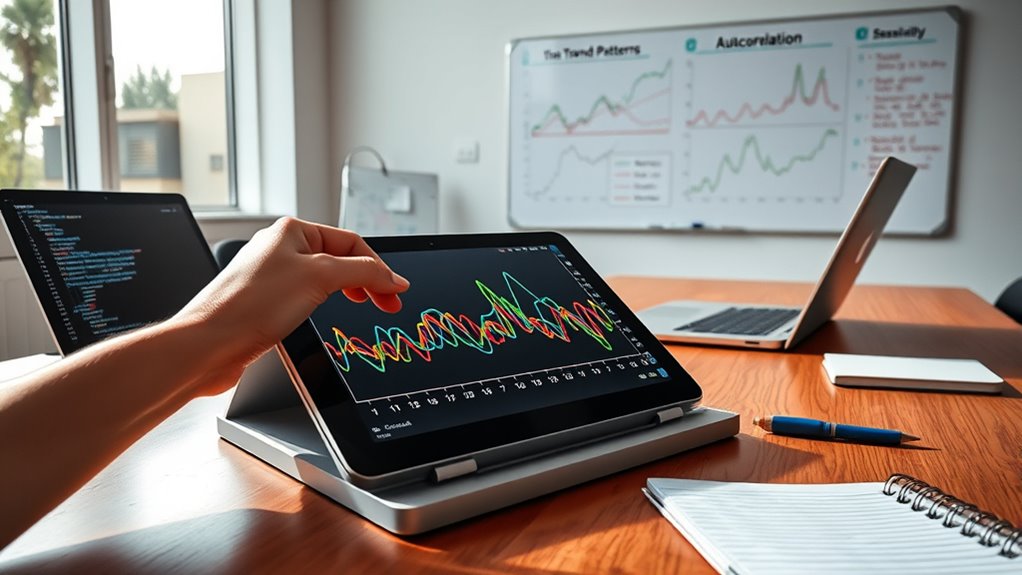
Ensuring reliable analysis starts with understanding the key data types and their unique characteristics. Time series data is recorded over consistent intervals, making it ideal for trend and pattern prediction. Vetted – Mother Baby Kids Cross-sectional data captures a snapshot at a single point in time across variables, offering immediate insights. Pooled or panel data combines these approaches, providing a broader perspective over time and variables. Longitudinal data tracks the same subjects, useful for observing changes. To guarantee accuracy, focus on data quality—accuracy, completeness, and consistency are essential. Address potential issues like missing data and outliers. Be aware of challenges like non-stationarity, seasonality, and noise, which can distort results. Properly managing these factors—including understanding data variability—will lead to more trustworthy, actionable insights in your analysis.
Frequently Asked Questions
How Do I Handle Missing Data in Time Series Analysis?
When you handle missing data in time series analysis, you need to choose appropriate imputation methods. You can use linear or spline interpolation, or fill gaps with previous or next values.
Consider seasonality and trends to avoid bias. Tools like Python’s Pandas or R’s ZOO help automate this process.
Properly managing missing data improves your model’s accuracy and reliability, ensuring better insights from your time series data.
What Are the Best Practices for Validating Time Series Models?
You want to know the best practices for validating time series models. First, split your data into training and testing sets, ensuring no future data leaks.
Use time series cross-validation or rolling window methods to respect the temporal order.
Focus on recent data for validation, and evaluate performance with metrics like RMSE or MAE.
Always prevent overfitting by increasing validation data size and keeping test data separate.
How Can I Detect Seasonality in My Data?
To detect seasonality in your data, start by visually inspecting your time series with run sequence or seasonal subseries plots, which can reveal repeating patterns.
Use autocorrelation function (ACF) plots to identify periodic correlations at specific lags.
You can also perform seasonal decomposition to separate seasonal components or apply seasonal differencing.
Combining these methods helps confirm the presence of seasonality and guides further analysis or modeling.
What Methods Improve Forecasting Accuracy for Non-Stationary Data?
Think of forecasting non-stationary data like trying to hit a moving target. To improve accuracy, you can apply differencing to remove trends, log transformations to stabilize variance, and seasonal adjustments for periodic patterns.
Using models like ARIMA, exponential smoothing, or Prophet helps account for these factors. Always validate your transformations with statistical tests, ensuring your data is ready for reliable predictions.
This iterative approach sharpens your forecast precision over time.
How Do I Visualize Complex Multivariate Time Series Effectively?
To visualize complex multivariate time series effectively, you should combine multiple techniques. Use heat maps to show high-dimensional data patterns, and stacked area charts for variable contributions over time.
Incorporate interactive dashboards for dynamic exploration, and apply dimensionality reduction tools like PCA or autoencoders to simplify data.
Additionally, utilize parallel coordinates or radial plots to display multiple variables simultaneously, making complex relationships clearer and insights easier to extract.
Conclusion
Understanding time series analysis isn’t just about numbers; it’s about uncovering stories hidden in data. While the techniques and tools can seem complex, they empower you to predict and plan with confidence. Yet, amidst the precision, remember that data can be unpredictable, reminding you of life’s uncertainties. Embrace both the clarity and chaos—your ability to navigate them defines your mastery in turning data into meaningful insights.



